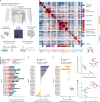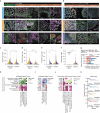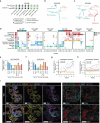Progressive plasticity during colorectal cancer metastasis
- PMID: 39478232
- PMCID: PMC11754107
- DOI: 10.1038/s41586-024-08150-0
Progressive plasticity during colorectal cancer metastasis
Erratum in
-
Author Correction: Progressive plasticity during colorectal cancer metastasis.Nature. 2025 Jan;637(8047):E28. doi: 10.1038/s41586-024-08560-0. Nature. 2025. PMID: 39789339 Free PMC article. No abstract available.
Abstract
As cancers progress, they become increasingly aggressive-metastatic tumours are less responsive to first-line therapies than primary tumours, they acquire resistance to successive therapies and eventually cause death1,2. Mutations are largely conserved between primary and metastatic tumours from the same patients, suggesting that non-genetic phenotypic plasticity has a major role in cancer progression and therapy resistance3-5. However, we lack an understanding of metastatic cell states and the mechanisms by which they transition. Here, in a cohort of biospecimen trios from same-patient normal colon, primary and metastatic colorectal cancer, we show that, although primary tumours largely adopt LGR5+ intestinal stem-like states, metastases display progressive plasticity. Cancer cells lose intestinal cell identities and reprogram into a highly conserved fetal progenitor state before undergoing non-canonical differentiation into divergent squamous and neuroendocrine-like states, a process that is exacerbated in metastasis and by chemotherapy and is associated with poor patient survival. Using matched patient-derived organoids, we demonstrate that metastatic cells exhibit greater cell-autonomous multilineage differentiation potential in response to microenvironment cues compared with their intestinal lineage-restricted primary tumour counterparts. We identify PROX1 as a repressor of non-intestinal lineage in the fetal progenitor state, and show that downregulation of PROX1 licenses non-canonical reprogramming.
© 2024. The Author(s).
Conflict of interest statement
Competing interests: K.G. is listed as an inventor on US patent 11,464,874, and US provisional patent applications 63/478,809 and 63/478,829 on targeting L1CAM to treat cancer, submitted by MSKCC. D.P. is on the scientific advisory board of Insitro. J.S. is a consultant for Paige AI. R.Y. has served on the advisory board for Pfizer, Mirati Therapeutics, Revolution Medicine, Loxo@Lilly and Amgen, received a speaker’s honorarium from Zai Lab, and has received research support from Pfizer, Boehringer Ingelheim, Mirati Therapeutics, Daiichi Sankyo, FogPharma and Boundless Bio. J.G.-A. owns stock in Intuitive Surgical. R.C. is a consultant for Sanavia Oncology, S2 Genomics and LevitasBio. The other authors declare no competing interests.
Figures
















Update of
-
Progressive plasticity during colorectal cancer metastasis.bioRxiv [Preprint]. 2023 Aug 21:2023.08.18.553925. doi: 10.1101/2023.08.18.553925. bioRxiv. 2023. Update in: Nature. 2025 Jan;637(8047):947-954. doi: 10.1038/s41586-024-08150-0. PMID: 37662289 Free PMC article. Updated. Preprint.
References
-
- Hanahan, D. Hallmarks of cancer: new dimensions. Cancer Discov.12, 31–46 (2022). - PubMed
MeSH terms
Substances
Grants and funding
LinkOut - more resources
Full Text Sources
Medical
Research Materials

